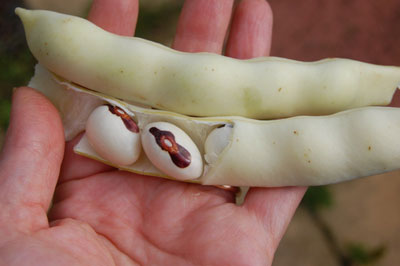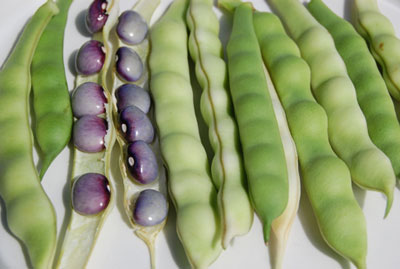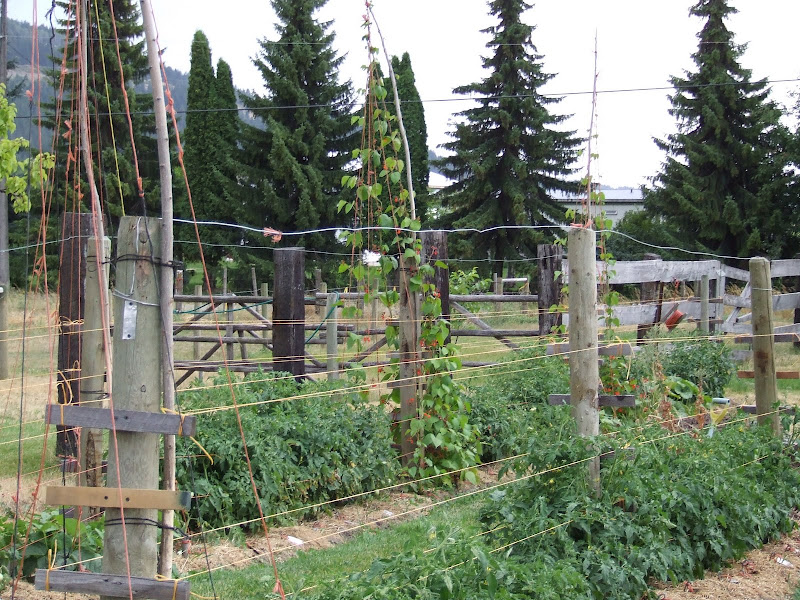|
|
Post by Rebsie on Nov 28, 2008 5:36:53 GMT -5
A couple of nice pole beans (or climbing French beans as we call them in this part of the world) from the Heritage Seed Library in the UK.  San Antonio San AntonioThis one is white with a chestnut brown blobby marking around the hilum, similar to Soldier beans or Nun's Belly Button. However you usually see this on kidney-shaped beans, and these are much larger, plump, rounded and kind of egg-shaped. A very pretty bean. The plants have enormous leaves and climb freely. It produces large, wide, flat green pods which turn pale yellow when fully mature. You can eat the pods when they're young but it's more suited to producing shelly beans, fresh or dried. The beans are huge when fresh. Overall yields are about average. They keep their hilum marking when cooked, but it turns more of a dark grey colour. Flavour is nice and the texture slightly dry and mealy but full of substance.  Poletschka PoletschkaA beautiful Ukrainian variety with very vigorous growth and generous yields. It produces masses of knobbly bright green pods which can be eaten when small. The plants are rampant climbers and set loads of pods. When shelled out fresh as above the beans are various lovely shades of purple and mauve but when fully mature they are a very dark purple-black. They are smallish, coco-shaped and rounded, and very very shiny, so the dried beans look a bit like blackcurrants! The beans cook to a chestnut-red colour and turn the cooking water black. They taste good and are very hearty. They cook quite easily from fresh but after drying they may need a good long soak as the skins tend to be quite thick and waterproof. |
|
|
|
Post by dogwoman on Nov 28, 2008 12:36:55 GMT -5
Those San Antonios are gorgeous! I'll be trying pole beans this year. I've been growing bush varieties. How tall do people generally make tee pees for pole beans? I have some five foot tall hog wire fence. I am wondering if that might be a good place to trellis pole beans?
Lorna
|
|
|
|
Post by bunkie on Nov 28, 2008 15:40:01 GMT -5
really beautiful rebsie! we grew pole beans for the first time this year and are planning on doing many more come spring. we used ten foot bamboo poles and the plants grew up and over them, and were so gorgeous!
|
|
|
|
Post by grunt on Nov 29, 2008 0:45:30 GMT -5
Lorna: Most of the pole beans I have grown would hit the top of the hog wire and make it back to the ground and start up again. Native Seed Search www.nativeseeds.org/v2/default.php has varieties that are both adapted to your area, and of appropriate height. Damn, that sounds dry. They have a lot of native american and mexican beans that don't get too tall, and they come from places a lot like where you are. They have several that would be called semi-determinate or intermediate climbers. For a taller teepee, I use a single pole with baler twine lines tied to the top and strung in a circle around the base of the pole. I drive a peg in the ground for each line, and space them about 15 inches apart around the pole.  The only real drawback is that you have to make sure your pole is sturdy enough to hold the weight of the mature plants, or you end up like the one on the far left here:  Some of the poles I had up were 15' tall, and the beans made it to the top and hung down. Cheers Dan |
|
|
|
Post by bunkie on Nov 29, 2008 13:25:20 GMT -5
great pics dan! i was wondering how many seeds do you put around each string? i put 5 around some, and those where only 3 germinated were too sparse, yet those where i put 7-10 seeds on each seemed too conglomerated if you know what i mean?! i had trouble keeping them all going around the poles. they tended to lean to one side or the other with their heaviness.
|
|
|
|
Post by grunt on Nov 29, 2008 22:21:24 GMT -5
Bunkie: I plant in a 3' X2' square around the base of the pole (to fit the bed width). I put 8 lines to a pole, and the total length of the sides of the square would be 10' so the line spacing is about 15". Each pole ends up with 30 beans planted around it, so they are evenly spaced at about 4". I think one of the tricks to avoid them all leaning to one side, is having the strings fairly tight to begin with. The other one is having a strong enough straight pole. I tie my bean poles to the fence posts I have in the rows, so they are easy to take down at the end of the season. Most of the beans we grow are for dry shelling, and it's really easy to pick them when you can flop the pole down and have a seat while you harvest.
I don't know whether that makes me lazy or qualifies as an intelligent way to do things, but it works.
Cheers
Dan
|
|
|
|
Post by grungy on Nov 29, 2008 23:05:24 GMT -5
Yes and having a short legged wife who helps with the harvesting doesn't hurt when you design thing either. LOL
Grungy
|
|
|
|
Post by Rebsie on Nov 30, 2008 8:29:23 GMT -5
That is a really good idea! I really should get round to installing some sturdy fence posts as I suspect they would make my life a heck of a lot easier. My current method is much more humble ... teepees made from 8ft bamboo canes because that was the largest size I could fit into my car!
|
|
|
|
Post by canadamike on Nov 30, 2008 16:51:46 GMT -5
These bambou canes can be made much longer Rebsie. Just by an approprietly sized dowell that can fit in the empty center, add some epoxy or epoxy putty to lock things together and voilà, 16 feet high strong and lightweight bamboo canes...
|
|
|
|
Post by dogwoman on Nov 30, 2008 17:27:02 GMT -5
Great information, everyone! Thanks for the photos, Grunt, inspiration!! I've already purchased a few types of pole beans for next year. I bought 'em, I'm gonna plant them!  Will look for beans native to this area next time, thanks for letting me know about them. I have the car problem, too, can't fit more than about 10' poles in the car. The backseat has a little hatch which can open into the trunk for skies! I don't ski, but sometimes that little option is very handy. The dowel in the bamboo is a neat trick, Mike. Lorna |
|
|
|
Post by Alan on Dec 2, 2008 14:31:29 GMT -5
Wow, those are some really beautiful beans Rebsie. Thanks for the review. Thanks Grunt and Mike for the tips. Pole beans are one crop I have yet to really dig into but I plan on cultivating a lot of them this year so any reviews, seeds, or tips would be terrific, particularly with beautiful pictures like those above.
Makes note to self: Take lots of pictures next year.
|
|
|
|
Post by canadamike on Dec 2, 2008 21:33:59 GMT -5
This notre to self could become everybody's motto for next year. Pictures are the one thing this forum lacks a lot. We will all grow by seeing more, make opinions more easily and benefit moe from others experiences. And they are the hell of a good assistant when it is time to review things in the winter, and also an excellent way to fight gardener's depression  |
|
|
|
Post by grunt on Dec 3, 2008 3:43:48 GMT -5
If you use Michel's tip on bamboo, and don't want to introduce permanent heavy posts into your garden, there is an alternative. Find some free or cheap metal pipe of a large enough diameter to handle your bamboo/pole/tbar. Cut the pipe into sections 2'-3' in length, and either drive them into the ground, or dig them in. You can fill the pipe with earth until there is only 6"-12" left empty, and stand your bamboo/pole/tbar in the socket. The result is as if the bamboo/pole/tbar was driven into the ground the full length of the pipe. At the end of the season, you can either leave the pipe in the ground for next season, or pull it to make tilling the soil a bit easier. I have 56 sockets permanently embedded in our original garden beds. I went to permanent fence posts in the other sections of the garden because my supply of free pipe ran out. I have to admit that I prefer the fence posts, just because I grow so many tomatoes that need a lot of support, and they lend themselves to the "ladder" support for the side lines.
The single pole bean teepees are very well suited to the socket idea, because you can spot them anywhere you can get a 3' square of dirt.
Cheers
Dan
|
|
|
|
Post by Rebsie on Dec 3, 2008 6:12:01 GMT -5
I'm glad the photos are useful ... I'm an obsessive-compulsive snapper and since my husband bought me a lovely new camera this year I've been even worse! I take dozens of pictures a day in the garden during the summer. In the old days when it was expensive to buy film I was more careful, but as digital photographs cost nothing to take or develop it makes sense to record every detail of the plants I'm growing, especially the rare heritage types and the breeding projects. It's nice to be able to share a few of them here.
Pictures do make a big difference. People are more keen to grow a variety they've seen pictures of, rather than just reading a description.
Alan, I'll happily send you some of my pole beans if you want to try them. These two and a few others will be going on my trades list whenever I eventually get round to compiling it.
And thank you Michel and Dan for the bamboo tips. I would never have thought of these ideas myself but they make a lot of sense.
|
|
|
|
Post by Rebsie on Dec 3, 2008 10:17:10 GMT -5
Kew Blue - another heirloom from the Heritage Seed Library This one is mainly an edible podded type. It's thought to have been bred at Kew Gardens in London. The plants are fairly vigorous with dark green leaves, and stems which are flushed from green to purple. The flowers are purple. Pods, which are borne in pairs all over the plant, are long and thin, flattish, straight-ish, and a really beautiful rich dark purple. They are silky smooth and a delight to look at.  The flavour is superb, very refined. They stay stringless for a long time. Inevitably they turn dark green when cooked, but are fine enough that you can get away with steaming them to preserve a little of the colour. The shelled beans can also be eaten ... they are quite firm with a pleasant nutty flavour. When dry they are flat kidney-shaped beans, a light buff colour with subtle brown mottling. 
|
|














